Tax Alert For High-Income And High Net Worth Individuals
Published Wednesday, June 23, 2021 at: 7:12 PM EDT

The political standoff in Washington, D.C., has complicated tax planning enormously. No one knows exactly how it will shake out but what we do know is that there are four possibilities to be prepared for.
1. The estate tax exemption is expected to be slashed dramatically, from $11.6 million, to $3.5 million per person, most likely. In addition, the estate tax rate could be stiffened.
2. Capital gain taxes could be hiked in a couple of ways. The current favorable capital gains tax rate of 20% could be eliminated if your taxable income is more than $1 million. In addition, the “step-up” in the basis accorded capital gains on inherited investments may be eliminated on gains of more than $1 million. If your current estate plan hinges on leaving highly appreciated assets, like stocks, business interests, real estate, and other investments, this would slash what your heirs inherit after paying taxes.
3. President Biden has proposed raising the top tax rate. In 2021, the top tax rate is 37% and that applies to income of more than $628,300 for joint filers. A new 39.6% income tax bracket is very possibly going to be adopted. Not only would the top tax rate rise to 39.6%, but the 35% tax bracket could be eliminated, which greatly expands the number of taxpayers subject to the 39.6%.
4. The value of itemized deductions could be capped at 28% for those in the new top tax bracket. To be clear, a high-income professional or business owner in the proposed 39.6% tax bracket, who deducts mortgage interest, would be entitled to a deduction of only 28 cents for each dollar paid in mortgage interest, instead of 39.6 cents on the dollar. Itemized deductions would lose 30% of their power in lowering your tax bill annually.
The matrix of variables is complex but keeping these four possible changes top of mind could significantly help minimize your federal income and estate taxes as tax-hike possibilities turn into certainties in the weeks ahead.
Nothing contained herein is to be considered a solicitation, research material, an investment recommendation, or advice of any kind, and it is subject to change without notice. Any investments or strategies referenced herein do not take into account the investment objectives, financial situation or particular needs of any specific person. Product suitability must be independently determined for each individual investor. Tax advice always depends on your particular personal situation and preferences. You should consult the appropriate financial professional regarding your specific circumstances. The material represents an assessment of financial, economic and tax law at a specific point in time and is not intended to be a forecast of future events or a guarantee of future results. Forward-looking statements are subject to certain risks and uncertainties. Actual results, performance, or achievements may differ materially from those expressed or implied. Information is based on data gathered from what we believe are reliable sources. It is not guaranteed as to accuracy, does not purport to be complete, and is not intended to be used as a primary basis for investment decisions. This article was written by a professional financial journalist for Advisor Products and is not intended as legal or investment advice.
This article was written by a professional financial journalist for Preferred NY Financial Group,LLC and is not intended as legal or investment advice.
An individual retirement account (IRA) allows individuals to direct pretax incom, up to specific annual limits, toward retirements that can grow tax-deferred (no capital gains or dividend income is taxed). Individual taxpayers are allowed to contribute 100% of compensation up to a specified maximum dollar amount to their Tranditional IRA. Contributions to the Tranditional IRA may be tax-deductible depending on the taxpayer's income, tax-filling status and other factors. Taxed must be paid upon withdrawal of any deducted contributions plus earnings and on the earnings from your non-deducted contributions. Prior to age 59%, distributions may be taken for certain reasons without incurring a 10 percent penalty on earnings. None of the information in this document should be considered tax or legal advice. Please consult with your legal or tax advisor for more information concerning your individual situation.
Contributions to a Roth IRA are not tax deductible and these is no mandatory distribution age. All earnings and principal are tax free if rules and regulations are followed. Eligibility for a Roth account depends on income. Principal contributions can be withdrawn any time without penalty (subject to some minimal conditions).
©2021 Advisor Products Inc. All Rights Reserved.

